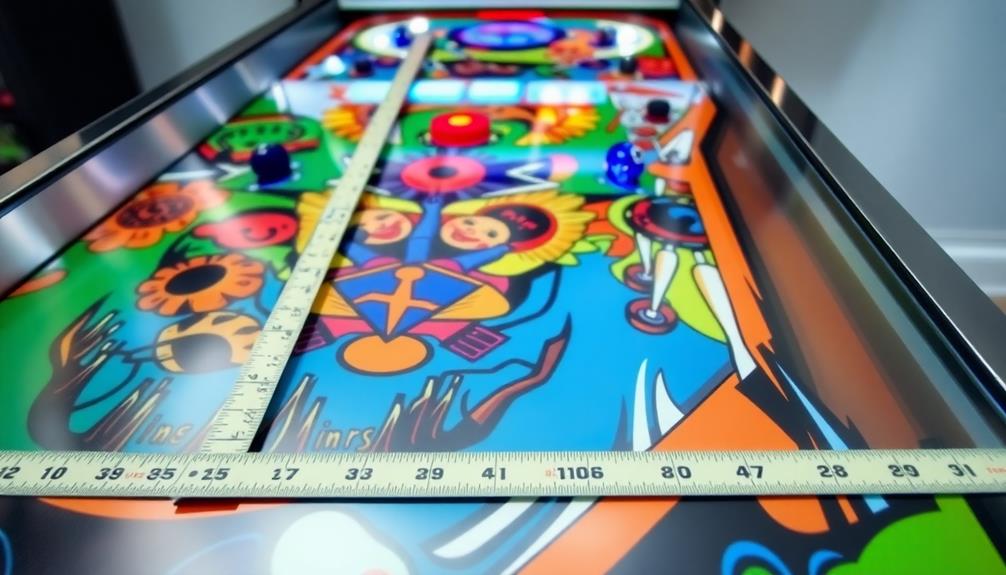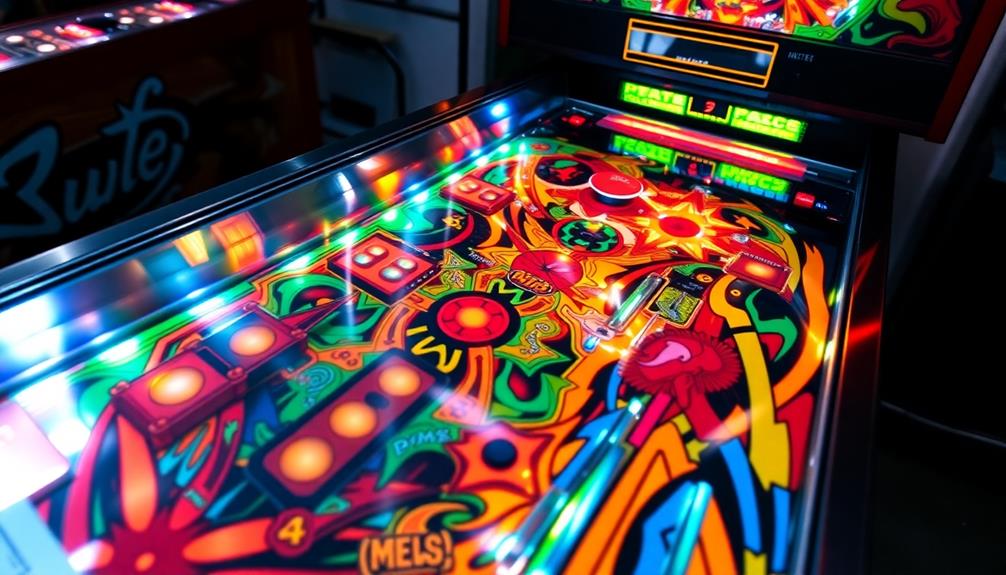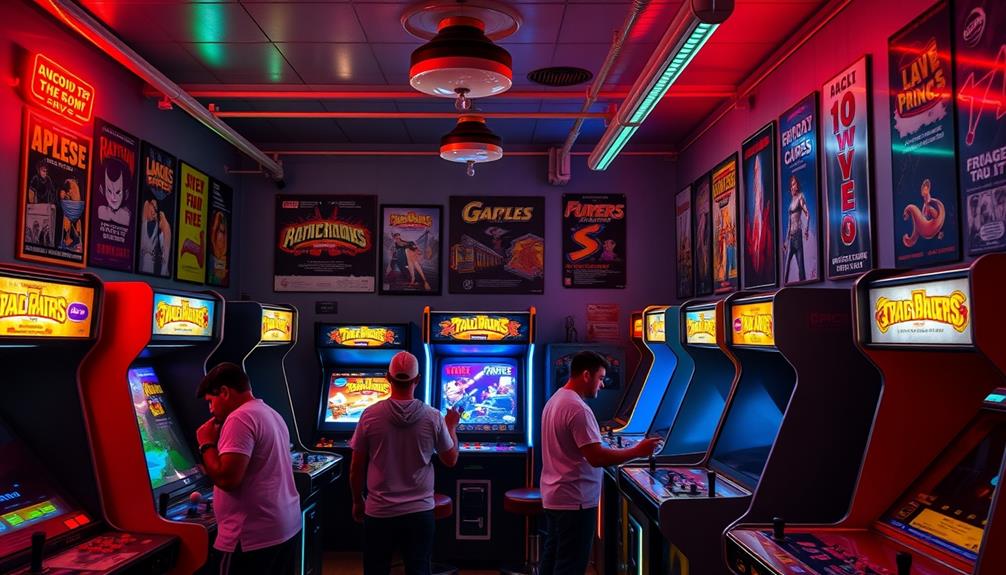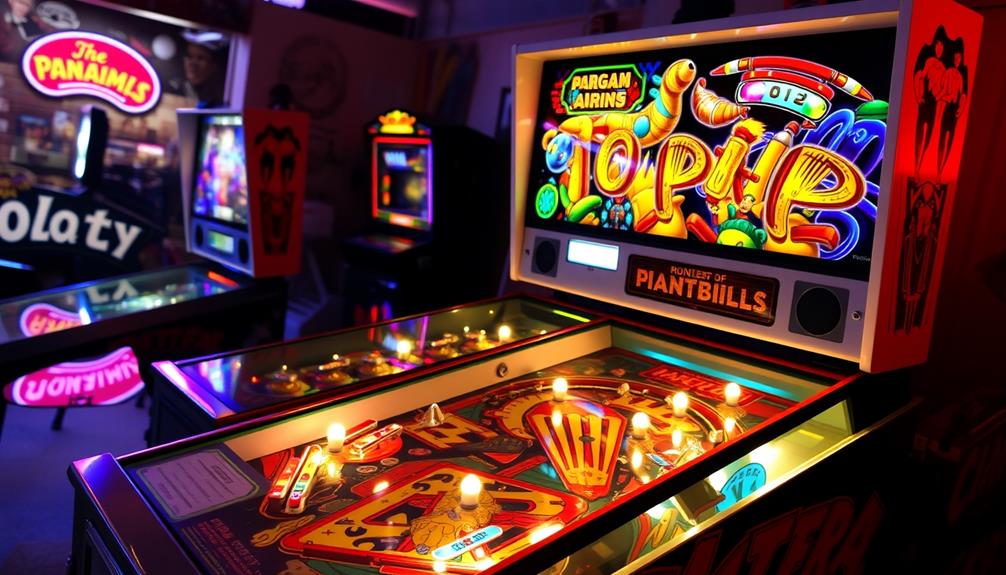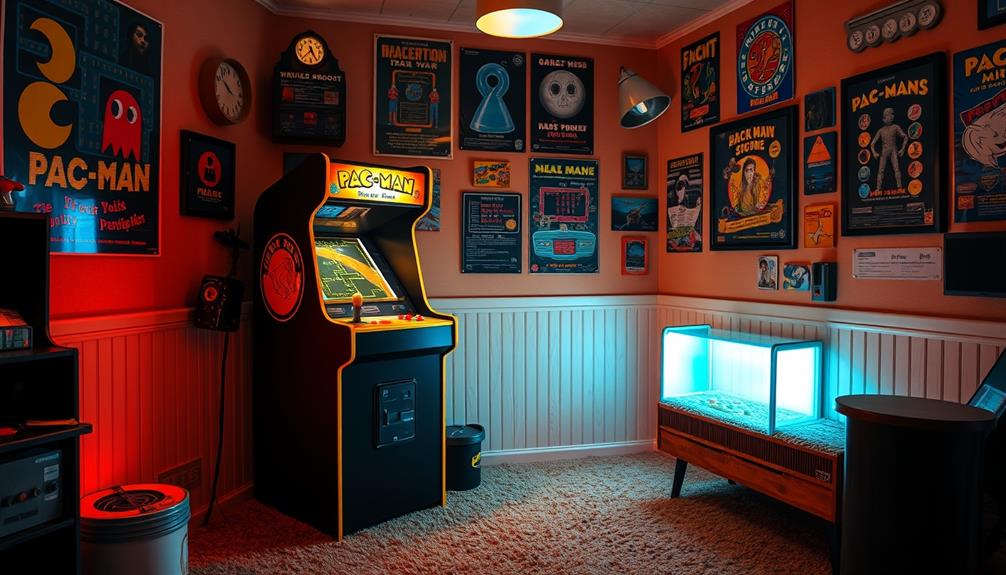In 1942, New York City prohibited pinball machines due to growing concerns about gambling and organized crime. Mayor LaGuardia viewed pinball as a threat to morality, associating it with juvenile delinquency and the exploitation of vulnerable players. He deemed the ban necessary during wartime to prevent citizens from suffering financial losses linked to gambling. The public turned against pinball, influenced by exaggerated media campaigns portraying it as a harmful influence. Raids led to the destruction of thousands of machines, demonstrating the city’s commitment to protecting the youth. If you’re curious about the evolution of pinball’s story from that point, there is more to discover!
Key Takeaways
- Pinball was banned in New York City in 1942 due to concerns about its association with organized crime and gambling.
- Mayor LaGuardia framed the ban as a moral necessity to protect youth from financial exploitation and juvenile delinquency.
- The ban was presented as a wartime measure, emphasizing resource conservation and public safety following the Pearl Harbor attack.
- Public raids led to the destruction of thousands of pinball machines, reinforcing the stigma surrounding the game.
- Negative media portrayals linked pinball to moral decay and gambling, intensifying public fear and opposition.
Historical Background of Pinball
Originating from the game Bagatelle, pinball quickly captured the imagination of many during the 1930s. As the Great Depression unfolded, pinball machines found their way into bars and amusement centers, offering an affordable form of entertainment.
However, early pinball machines lacked flippers and relied heavily on chance, leading to concerns about gambling. Players often wagered small prizes or free games, which raised eyebrows among politicians and citizens alike. This situation paralleled the growing concerns over financial practices like overspending, as many individuals sought cheap thrills during tough economic times.
As pinball's popularity grew, so did the political and media backlash. Many perceived it as a threat, especially to youth, claiming it exploited vulnerable citizens financially.
The situation escalated, and in light of the Pearl Harbor bombing, New York City Mayor Fiorello LaGuardia took action. He framed the ban on pinball machines as both a moral and wartime necessity, emphasizing the need to protect citizens from gambling's influence.
On January 21, 1942, the official ban was enacted. This resulted in police raids that confiscated thousands of machines and publicly destroyed them to assert the city's stance against gambling and organized crime.
This marked a significant turning point in the history of pinball in New York City.
Reasons for the Pinball Ban

In the early 1940s, concerns about pinball machines escalated, leading Mayor Fiorello LaGuardia to implement a ban in New York City. He linked banned pinball to organized crime and juvenile delinquency, arguing that these machines were a form of gambling that exploited vulnerable citizens. LaGuardia believed the negative impacts of pinball on youth were significant and needed to be addressed urgently.
The moral implications of gambling, as seen in various contexts like financial implications in divorce, further fueled the argument against pinball machines. The ban was also framed as a wartime necessity. Following the Pearl Harbor bombing, LaGuardia asserted that pinball machines consumed valuable materials essential for the war effort. By eliminating these distractions, he aimed to redirect focus toward supporting the nation during a critical time.
After the ban, police raided establishments across the city, confiscating thousands of pinball machines. Public destruction events were staged, showcasing the crackdown for media coverage and reinforcing the negative perception of the game.
This moral panic surrounding gambling extended beyond New York, leading to similar bans in cities like Oakland and Chicago. LaGuardia's actions not only reflected wartime priorities but also created long-lasting stigma against pinball that persisted for decades.
Mayor LaGuardia's Role

When you think about the pinball ban in New York, Mayor Fiorello LaGuardia's influence stands out.
He linked the game to organized crime and a moral panic that swept through the city, convincing many that it was a threat to public safety.
The ban was rooted in societal anxieties, much like the fears surrounding Borderline Personality Disorder (BPD) and its emotional instability.
Moral Panic Perception
Mayor LaGuardia's fervent campaign against pinball in the 1940s exemplifies how moral panic can shape public policy. His administration framed pinball machines as gambling devices that contributed to juvenile delinquency, tapping into the societal fears of the time.
LaGuardia linked these machines to organized crime, arguing they exploited vulnerable individuals financially. This moral panic crescendoed after the Pearl Harbor bombing, as he positioned the ban as a wartime necessity, claiming that pinball machines wasted vital resources needed for the war effort.
In a similar vein, the public often reacts strongly to perceived threats to health and safety, much like the concerns surrounding the use of essential oils for toothache relief.
To bolster his agenda, LaGuardia launched public raids, seizing and destroying thousands of pinball machines, which reinforced the anti-pinball sentiment across New York City.
The portrayal of pinball as a social ill resonated with contemporary fears about gambling and its detrimental effects on youth. By tapping into these anxieties, LaGuardia effectively mobilized public support for the ban, illustrating how moral panic can drive significant changes in legislation and societal norms.
In this way, you can see how perceptions of morality and public safety can lead to drastic measures, shaping the landscape of leisure activities and altering the lives of countless individuals in the process.
Organized Crime Connection
Amid the chaos of World War II, Fiorello LaGuardia seized the opportunity to link pinball machines with organized crime, arguing that they served as tools for mobsters to exploit the city's vulnerable populations. In 1942, LaGuardia initiated a ban on pinball in New York City, claiming these machines were gateways to financial ruin, similar to how certain investments can lead to significant risks if not properly managed, such as in the case of risk management strategies for Bitcoin IRAs.
He believed the pinball industry was rife with corruption, undermining public morality during a time of national crisis.
LaGuardia's campaign to combat organized crime was aggressive and theatrical. He famously demonstrated his stance by destroying seized pinball machines with a sledgehammer in public, a dramatic act meant to symbolize his commitment to protecting the city's youth from the perceived dangers of gambling.
This media-savvy approach garnered significant attention, framing the ban as a necessary measure to curb mob influence.
The connection LaGuardia made between pinball and organized crime resonated with many New Yorkers, who viewed the ban as a way to restore order amidst wartime chaos.
Ultimately, LaGuardia's anti-pinball crusade marked a pivotal moment in the city's history, illustrating how moral concerns and the fight against organized crime shaped public policy.
Public Perception of Pinball

When you think about pinball, it's hard to ignore how its image has been tarnished by concerns over youth gambling and moral panic.
The philosophical exploration of societal impacts often emphasizes the need for ethical decision-making frameworks when evaluating recreational activities.
Media coverage often painted pinball as a dangerous influence, suggesting it exploited vulnerable kids and led them down a path of delinquency.
This negative narrative, fueled by political figures, shaped public perception and created a lasting stigma around the game.
Youth and Gambling Concerns
Worried about the impact of pinball on youth, many community members viewed the game as a gateway to gambling. Critics argued that pinball machines encouraged gambling behaviors, with players often betting on outcomes, risking their pocket money for small prizes or free games. This perception fueled fears of financial exploitation and moral decay among schoolchildren, similar to concerns raised in community building through the Law of Attraction about collective energy affecting youth.
Media portrayals linked pinball to juvenile delinquency and organized crime, amplifying public concern. Mayor Fiorello LaGuardia famously characterized pinball as a mob-controlled gambling racket, which only intensified the opposition to the game. These narratives painted pinball as not just a harmless pastime but a serious threat to the integrity of young people.
As pinball machines became more prevalent, many adults saw them as a catalyst for negative behaviors, believing they could lead youth down a troubling path. The moral panic surrounding pinball mirrored broader societal fears about emerging gaming trends.
Ultimately, this public perception of pinball as a vice contributed considerably to its ban, as community members prioritized the well-being of youth over the allure of the game.
Moral Panic Narrative
Throughout the 1940s, the public's perception of pinball was shaped by a burgeoning moral panic that framed the game as a tool of organized crime and a catalyst for juvenile delinquency. This narrative painted pinball machines as gambling devices that exploited youth, leading authorities to view them as a societal threat. Concerns about the influence of entertainment on young people were prevalent, much like today's discussions about trust issues with boyfriends and their impact on relationships.
- Newspapers sensationalized stories linking pinball to financial ruin and criminal activity.
- Political figures, like Mayor Fiorello LaGuardia, condemned the machines, claiming they were mob-controlled.
- Wartime resource shortages fueled arguments that pinball machines wasted materials better used for the war effort.
As a result, the ban on pinball was justified under the guise of moral necessity. Critics claimed the game corrupted vulnerable individuals, echoing modern concerns about video games.
Despite the ban, pinball didn't disappear; it thrived in underground venues, revealing a cultural divide. Many still saw it as harmless entertainment, contrasting sharply with the prevailing moral panic narrative.
This tension highlighted a society grappling with changing values and the fear of juvenile delinquency, ultimately leading to pinball's vilification during this tumultuous era.
Media Influence and Criticism
The negative media portrayals of pinball intensified the public's fear and opposition, painting it as a gateway to gambling and juvenile delinquency. In the 1940s, newspapers launched campaigns that sensationalized pinball, linking it to organized crime and financial exploitation. This criticism played into broader societal concerns about youth and morality, amplifying the perception that pinball was a detrimental influence.
Additionally, the reliance on sensationalist narratives echoed the global chaos around technology that often influences public sentiment during crises. You might've noticed how the media influence shaped public opinion, creating an environment ripe for panic. As moral crusaders decried pinball machines as tools that preyed on the vulnerable, many began to view the game as a serious gambling threat. The narrative pushed by the press painted pinball as not just a game, but a moral failing in the eyes of society.
This relentless criticism culminated in widespread support for the ban initiated by Mayor Fiorello LaGuardia. With the media framing pinball as a menace, the idea of prohibition gained traction, leading many to agree with the notion that eradicating pinball was essential for protecting the city's youth and moral fabric.
Roger Sharpe's Advocacy

Roger Sharpe emerged as a key figure in the fight to legalize pinball in New York City during the mid-1970s.
As a dedicated pinball historian and writer for GQ magazine, he recognized the game's unique aspects and set out to change the negative perceptions surrounding it.
His pivotal moment came in April 1976, when he testified before the NYC Council to demonstrate that pinball is a game of skill, not chance.
In the spirit of nurturing an imaginative mindset, Sharpe executed a flawless shot during his demonstration, illustrating the strategic elements of gameplay.
His efforts were supported by the American Association of New York, which campaigned tirelessly against the ban.
Sharpe's testimony helped shift lawmakers' views, presenting pinball as a legitimate pastime.
Lifting the Ban in 1976

After years of advocacy, 1976 became a landmark year for pinball enthusiasts in New York City. The lifting of the ban in 1976 marked a turning point for a game that had faced decades of prohibition.
Pinball historian Roger Sharpe played a vital role in this significant change. By demonstrating that pinball was indeed a game of skill rather than mere chance, he challenged the long-held perceptions that had led to its banning.
During a pivotal City Council meeting, Sharpe made a challenging shot on a pinball machine, showcasing the skill involved in the game. His successful demonstration swayed council members, convincing them to reconsider pinball's reputation and legality.
This moment was more than just a victory for Sharpe; it signified a broader cultural shift in how society viewed recreational activities.
After the repeal, pinball machines began to reappear in public spaces, regaining their popularity. Inspired by New York's decision, other cities followed suit, easing restrictions on pinball machines and contributing to a renaissance of the game across the United States.
The lifting of the ban not only revitalized pinball but also reshaped its place in American culture.
Cultural Impact of Pinball

Nostalgia for pinball has sparked a cultural revival, transforming it from a once-demonized pastime into a beloved symbol of community and competition.
Once seen through the lens of mob activity and gambling threats, pinball in New York has re-emerged as a cherished activity that brings people together. The ban, enforced by the New York City Mayor, may have aimed to curb alleged juvenile delinquency, but it only fueled the underground scene.
Today, you can find pinball thriving in various venues, where enthusiasts gather to enjoy friendly competition and reminisce about the game's storied past.
This revival comes with:
- A resurgence of pinball leagues and tournaments, fostering camaraderie among players.
- An explosion of retro-themed bars and arcades celebrating classic machines.
- Increased appreciation for the artistry and craftsmanship behind pinball design.
The repeal of the ban in 1976 marked a turning point, allowing pinball to reclaim its place in the cultural fabric of New York.
Now, it stands not just as a game, but as a vibrant part of the community, proving that the love for pinball endures.
Legacy of the Pinball Era

Pinball's cultural revival hasn't just redefined its role in social gatherings; it also set the stage for a powerful legacy that reshapes how we view this iconic game. Initially, pinball machines faced heavy scrutiny, especially under Mayor Fiorello LaGuardia's 1942 ban, which labeled them as gambling threats.
Yet, this prohibition only fueled their underground popularity, proving the game's irresistible allure.
The turning point came in 1976 when Roger Sharpe showcased pinball as a game of skill, leading to the repeal of the ban and reintegrating pinball into mainstream culture. This moment signified a shift in public perception, allowing people to appreciate pinball for its strategic elements rather than just its gambling connotations.
Fast forward to the late 2000s, and you see a vibrant resurgence of pinball, with new manufacturers and licensed themes enchanting audiences once more.
Today, the legacy of the pinball era inspires community engagement through leagues and tournaments, celebrating not just competition but the social significance of this beloved pastime.
The journey from a banned activity to a celebrated game illustrates how pinball machines have secured their place in our cultural fabric.
Frequently Asked Questions
Why Did They Ban Pinball in New York?
They banned pinball in New York due to concerns about gambling and organized crime. The authorities believed it diverted resources needed for the war effort, leading to confiscations and public destruction of machines for dramatic effect. When pinball was banned, it drove the game underground, with illegal speakeasies and secret clubs featuring hidden machines. The ban was eventually lifted in 1976 when the mayor of New York City staged a pinball tournament to prove that it was a game of skill, not chance. Since then, pinball has regained popularity and is no longer associated with organized crime. The overturning of the ban also brought attention to the outdated and misconstrued reasons why pinball was illegal in the first place. It was revealed that the concerns about gambling and organized crime were largely unfounded, and the diversion of resources for the war effort was no longer relevant. As a result, pinball was able to emerge from the shadows and reclaim its status as a beloved and innocent pastime. Today, it is enjoyed by people of all ages and is a cherished part of arcade and gaming culture.
Why Was There a 35 Year Ban on Pinball?
During the 35-year ban on pinball, over 300,000 machines were seized and destroyed. You'll find the ban stemmed from fears of gambling and juvenile delinquency, reflecting societal concerns about moral decay in wartime America.
Where Is Pinball Still Illegal?
Pinball's still illegal in several areas, including Oakland, California, and certain jurisdictions in New York. Local laws often classify it under gambling regulations, limiting its presence in public venues due to outdated moral concerns.
What Is the Pinball Machine Controversy?
You might not believe it, but pinball machines sparked a fierce controversy. Authorities linked them to crime and delinquency, leading to a ban in New York City, stirring underground popularity despite strict enforcement and public raids.
Conclusion
In the end, New York's ban on pinball reflected broader societal concerns about gambling and youth behavior. While some might argue that banning it stifled creativity and fun, it was a reaction to a time when pinball machines were often associated with vice. However, the eventual lifting of the ban in 1976 allowed pinball to flourish, transforming it into a celebrated cultural icon that continues to resonate today, showcasing the resilience of a beloved pastime.


